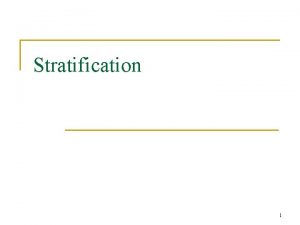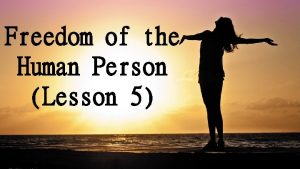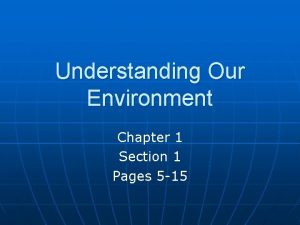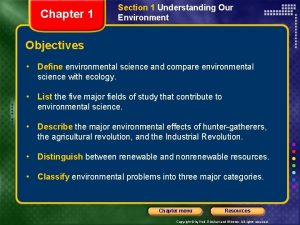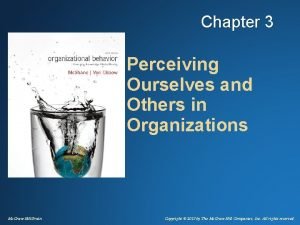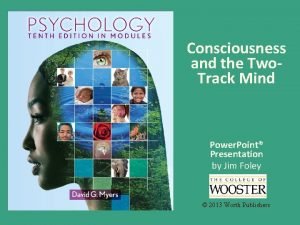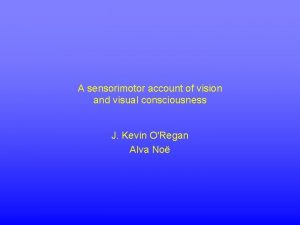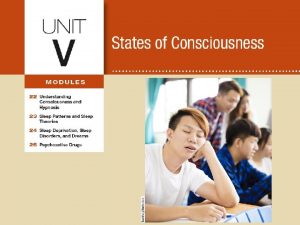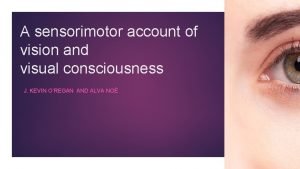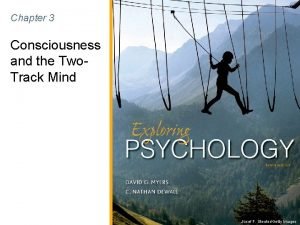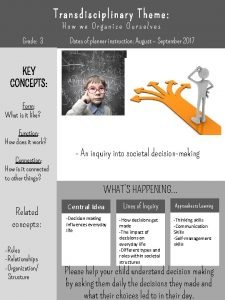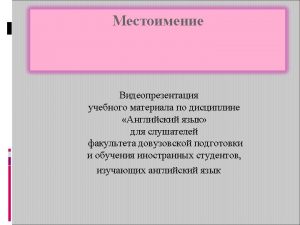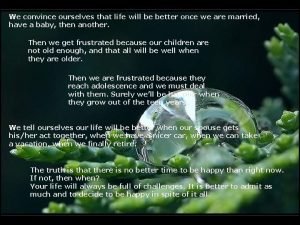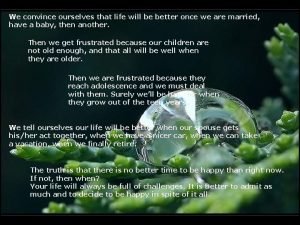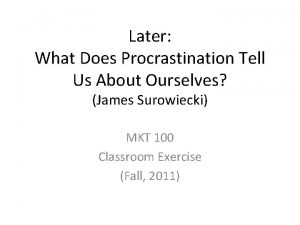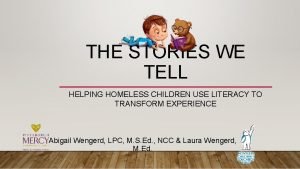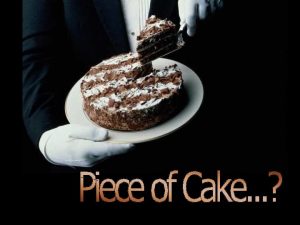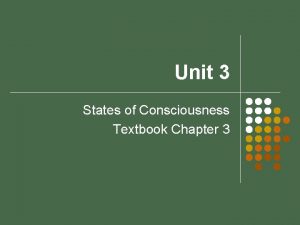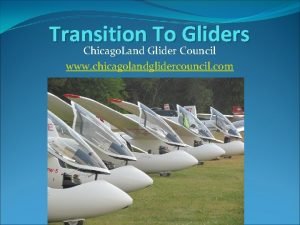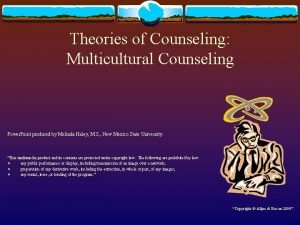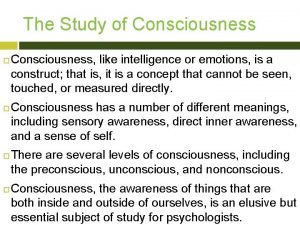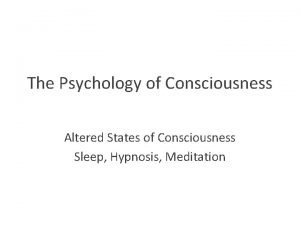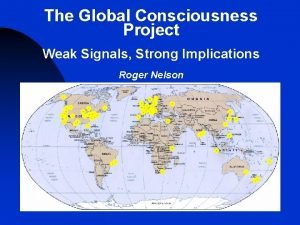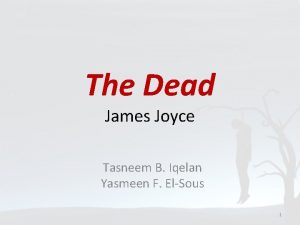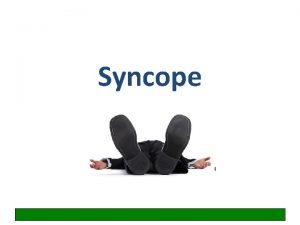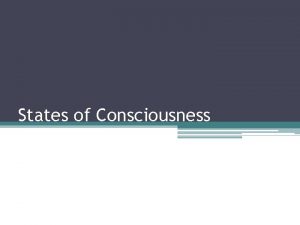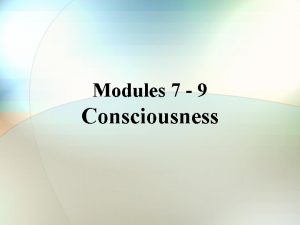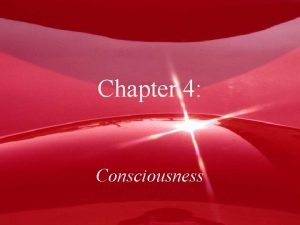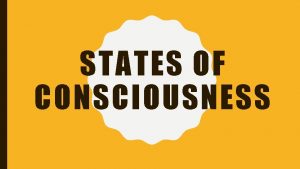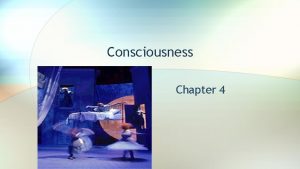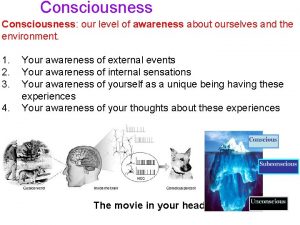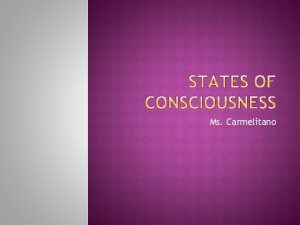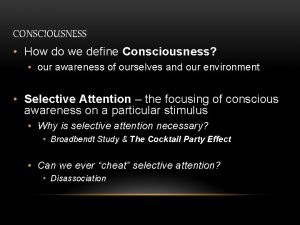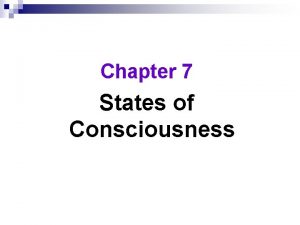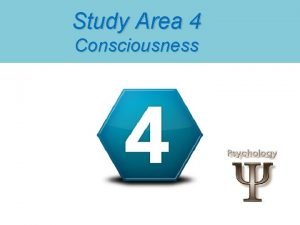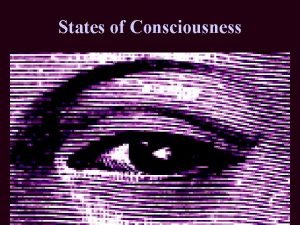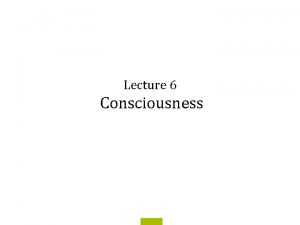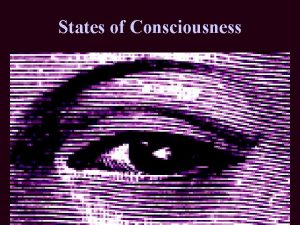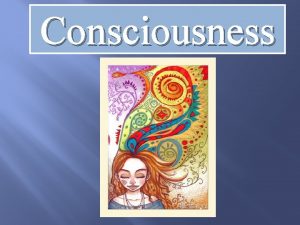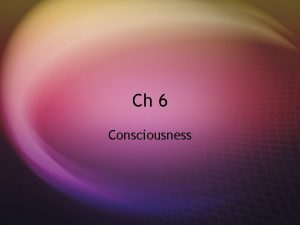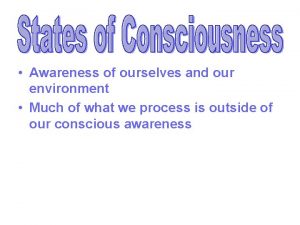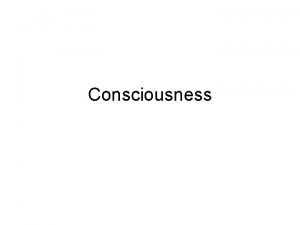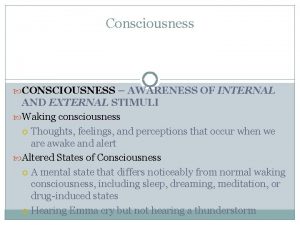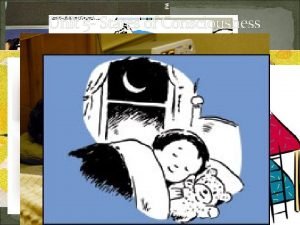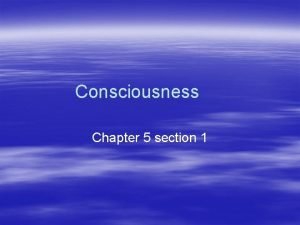CONSCIOUSNESS AWARENESS OF OURSELVES AND OUR ENVIRONMENT What



























































- Slides: 59


CONSCIOUSNESS AWARENESS OF OURSELVES AND OUR ENVIRONMENT What variations in consciousness exist in human beings?

DUAL PROCESSING • Mental processes operating at two levels – a conscious one and an unconscious one • Any examples of how we may be unaware of our true thoughts, feelings, and actions? • Unconscious parallel processing • Serial conscious processing

WHAT ABOUT MULTITASKING? • How good are we at multi-tasking? • Listening to music while working? • Texting and driving? • Any other common examples?

SELECTIVE ATTENTION • The focusing of conscious awareness on a particular stimulus • Why is selective attention necessary? • Broadbendt Study • Can we ever “cheat” selective attention? • Disassociation • Cocktail party effect

STUDYING CONSCIOUSNESS

STUDYING CONSCIOUSNESS

INATTENTIONAL BLINDNESS • Failing to see visible objects when our attention is directed elsewhere • How do we explain change blindness? • The “Pop-out phenomenon”

SO… WHY STUDY CONSCIOUSNESS? • Our consciousness is always changing for various reasons • How and why does conscious vary? • Biological rhythms • Sleep and dreams • Hypnosis • Meditation • Drugs

SLEEP: A TRUE/FALSE QUIZ • When people dream, their limbs act out in concert with their dream • Humans are the only living creatures that dream • Some people rarely have dreams • If you die in your dream, you die in real life • It is not safe to wake someone up while they are sleepwalking

Sleep


BIOLOGICAL RHYTHMS • Types of cycles/rhythms • Circadian Rhythm – 24 -hour cycles of varying alertness (sleep), body temperature, and growth • Disruptions? • What about naps? • Ninety-minute sleep cycles • What is the role of melatonin in sleep?


SLEEP: A STATE OF CONSCIOUSNESS • Sleep and wakefulness influenced by our circadian rhythms • Considerable mental and physical activity throughout the night

THE STAGES OF SLEEP § Stages 1 -4 = Non-REM Sleep (NREM) § Stages 1 -2: Early light sleep; theta waves. • A person daydreaming also shows theta activity. • Hypnic jerks and sleep spindles • Lasts 10 -30 minutes § Stages 3 -4: Deep sleep starts • heart rate & blood pressure decline • some non-vivid dreams • Roughly 30 minutes

THE STAGES OF SLEEP • Stage 5: REM Sleep Rapid eye movement, occurs during dreaming • Characteristics • occurs every 90 minutes (on avg) in humans • increases in length as night progresses • paralyzed body • lucid dreams


• What time should I wake up? ? ?

SLEEP DEPRIVATION • What is the purpose of sleep? • Recuperation, remembering, growing • What happens if we don’t sleep? • • • Fatigue Impaired concentration. Emotional irritability. Depressed immune system. Hallucinations and paranoia • 60 Minutes

SLEEP DEPRIVATION • Study on college students (Pilcher & Walters, 1997) • Participants complete cognitive test after either 8 hours of sleep or 24 hour sleep deprivation • All subjects asked to rate their effort, concentration, and estimated performance on the task Results: although sleep deprived subjects performed worse on the task, they rated their effort, concentration, and performance higher than the sleep group!

WHY DO WE SLEEP?

SLEEP DISORDERS • Narcolepsy – disease marked by sudden and irresistible onsets of sleep during normal waking periods • wakefulness to REM sleep for about 10 -20 minutes • cause unknown

SLEEP DISORDERS • Insomnia: • difficulty falling asleep, remaining asleep and persistent early-morning wakening • Prevalence: • 15% adults report severe insomnia • 15% adults report mild/occasional • Increases with age “Sleep-state-misperception”: • 5% insomniacs show sound sleep patterns

INSOMNIA (CONTINUED) • Causes of Insomnia: • • • Anxiety Tension Stress Depression drugs (cocaine) Treatments: • Sedative pills • Problems: overdose, dependency, de-sensitization, carry-over effects • Sleep restrictions

SLEEP DISORDERS (CONTINUED) • Somnambulism (Sleep Walking) person arises and wanders while asleep • tends to occur in first 2 hours of sleep • causes unknown • Not related to emotional or psychological problems • Occurs mostly in children, peak at 11 -12 yrs • It IS safe to awaken people gently from sleepwalking

SLEEP DISORDERS • Sleep apnea – frequent, temporary halt of breathing for 15 -60 seconds while sleeping • prevalent in 5% men 40 -60 yrs old • CNS ceases to function, causing diaphragm to stop moving or loss of muscle tone in tongue and throat

SLEEP DISORDERS (CONTINUED) • Nightmares – anxiety-arousing dreams, lead to awakening from REM sleep • • correlation between stress and nightmares prevalent in 10% adults persistent nightmares in children may reflect emotional disturbance • Night terrors – abrupt awakenings from Non. REM sleep accompanied by intense arousal and panic - most common in children 3 -8 - not indicative of emotional disturbance

OTHER SLEEP DISORDERS • Sleep apnea • Parasomnia • Sleepwalking (somnambulism) • Night terrors • REM Motor Disorder • Restless leg syndrome • Nightmares

DREAM THEORY • What is the importance of dreams? What meaning, if any, do you attach to dreams? • Read qualitative recaps of dreams provided • Are these dreams more than the “nonsensical noise of a restless brain stem” as one researcher described them?


• Ed was 57 when his wife Mary died of cancer after 32 years of marriage. When he dreamed about her shortly after her death in June of 1980, he experienced it as a precious moment of being with her, and wrote it down. Two months later, he dreamed about her again, and wrote that one down too. Soon he found himself writing down every dream in which she appeared. In the first 22 years after her death, he wrote down 143 dreams -- as few as two in one year, as many as 14 in another. The dreams have much in common with other dreams of deceased loved ones. In a few early dreams she comes back to life or provides him with reassurance that she is doing well. Many dreams are about the time of her final illness, but others are about their earlier life together, providing a portrait of a marriage. • Bea's vivid dream reports from age 14 to 16 provide one of the longest and most detailed dream journals we have from a young teenager. • Jasmine is a young woman who recorded hundreds of her dreams from age 14 to 27. In addition to the young age at which Jasmine started keeping a dream journal, there is another unique feature to this series: the

WHY DO WE DREAM? 1. Wish Fulfillment: Freud suggested the dreams provide a psychic safety valve to discharge unacceptable feelings. The dream’s manifest (actual) content may also have symbolic meanings (latent content) that signify our unacceptable feelings. 2. Information Processing: Dreams may help sift, sort, and fix day’s experiences in our memories.

WHY DO WE DREAM? 3. Activation-Synthesis Theory: Suggests that in the brain engages in a lot of neural activity that is random. Dreams make sense of this activity. All dream researchers believe we need REM sleep. When deprived of REM sleep, and then allowed to sleep, we show increased REM sleep called REM Rebound.

WHAT DO WE DREAM? 1. Negative Emotional Content: Eight out of 10 dreams have negative emotional content. 2. Failure Dreams: People commonly dream about failure, being attacked, pursued, rejected or struck with misfortune. 3. Sexual Dreams: Contrary to our thinking sexual dreams are sparse. Sexual dreams in men are 1 in 10; and in women 1 in 30.

(Activity)

Variations in Consciousness Hypnosis

History of Hypnosis Franz Anton Mesmer (18 th century) James Braid and James Esdaile (19 th century) Milton Erickson (20 th century)

Hypnosis § Social interaction in which one person suggests to another that certain perceptions, feelings, thoughts, or behaviors will spontaneously occur.

Components of Hypnosis 1. 2. 3. Hypnotic Induction Posthypnotic Suggestion Posthypnotic Amnesia

Explaining Hypnosis § How can we rationally or logically explain hypnosis?

Clinical/Therapeutic Uses of Hypnosis Anesthesia Acute and Chronic Pain § Phobias § PTSD and anxiety § § Depression Eating Disorders Dissociative Identity Disorder § Smoking § § § 42

Is Hypnosis Really an Altered State of Consciousness? § Divided Consciousness Theory: hypnosis creates a dissociation in consciousness (Ernest Hillgard) – Dissociation: § “Altered consciousness” communicates with the hypnotist and external world § A “hidden observer” is what the subject is aware of § Social influence theory


REST

TIRED

DREAM

AWAKE

SNORE

BED

EAT

SLUMBER

SOUND

COMFORT

WAKE

NIGHT

(End of Activity)

Déjà vu § Fr: “already seen” § The illusion of having already experienced something actually being experienced for the first time § Reported by 70% of the population

Why Does Déjà vu Occur? § “Memories gone wrong? ” – reminder of similar stimuli from our past – Sensory information going directly to LTM, THEN to STM – fragments of encoded memories § Reminder of unconscious fantasy? § Misfiring in the temporal lobe?
 Our awareness of ourselves and our environment
Our awareness of ourselves and our environment Our awareness of ourselves and our environment
Our awareness of ourselves and our environment Our awareness of ourselves and our environment.
Our awareness of ourselves and our environment. Our awareness of ourselves and our environment is called
Our awareness of ourselves and our environment is called Types of mobility
Types of mobility Consciousness adalah
Consciousness adalah Two states of mind hypnosis
Two states of mind hypnosis Sublimation psychology
Sublimation psychology Privacy awareness and hipaa privacy training cvs
Privacy awareness and hipaa privacy training cvs Lex aeterna meaning
Lex aeterna meaning Financial environment of business
Financial environment of business What do you do to protect the environment
What do you do to protect the environment Chapter 1 section 1 understanding our environment answers
Chapter 1 section 1 understanding our environment answers Learning objectives of our environment
Learning objectives of our environment Our environment class 6
Our environment class 6 Section 1 understanding our environment answer key
Section 1 understanding our environment answer key Perceiving ourselves and others in organizations
Perceiving ourselves and others in organizations Thinking affects our language, which then affects our:
Thinking affects our language, which then affects our: Our census our future
Our census our future Words to christ be our light
Words to christ be our light Marcus aurelius our life is what our thoughts make it
Marcus aurelius our life is what our thoughts make it We bow our hearts we bend our knees
We bow our hearts we bend our knees Our census our future
Our census our future Our life is what our thoughts make it
Our life is what our thoughts make it Money madness explanation
Money madness explanation God our father christ our brother
God our father christ our brother Our future is in our hands quotes
Our future is in our hands quotes Two track mind examples
Two track mind examples A sensorimotor account of vision and visual consciousness
A sensorimotor account of vision and visual consciousness Module 22 understanding consciousness and hypnosis
Module 22 understanding consciousness and hypnosis Consciousness outside the brain
Consciousness outside the brain Chapter 3 consciousness and the two-track mind
Chapter 3 consciousness and the two-track mind History helps us to understand other people
History helps us to understand other people Transdisciplinary theme who we are
Transdisciplinary theme who we are How we organize ourselves central idea
How we organize ourselves central idea Reflexive verbs are verbs that we do to ourselves.
Reflexive verbs are verbs that we do to ourselves. Agata miklis
Agata miklis We convince ourselves that life will be better
We convince ourselves that life will be better Yourself plural
Yourself plural Yourself themselves
Yourself themselves Let's me introduce myself
Let's me introduce myself Convince ourselves
Convince ourselves We convince ourselves that life will be better
We convince ourselves that life will be better 9695 syllabus
9695 syllabus What does procrastination tell us about ourselves
What does procrastination tell us about ourselves The stories we tell ourselves
The stories we tell ourselves Governing ourselves
Governing ourselves Seeing ourselves through the eyes of god
Seeing ourselves through the eyes of god Let's remind ourselves
Let's remind ourselves 2 corinthians 13:5
2 corinthians 13:5 We ask ourselves
We ask ourselves Virginia woolf performer heritage
Virginia woolf performer heritage 3 states of consciousness
3 states of consciousness Time of useful consciousness
Time of useful consciousness Theories of multicultural counseling
Theories of multicultural counseling Levels of consciousness examples
Levels of consciousness examples Altered state of consciousness psychology
Altered state of consciousness psychology Global consciousness project
Global consciousness project James met is dead
James met is dead Loss of consciousness
Loss of consciousness




